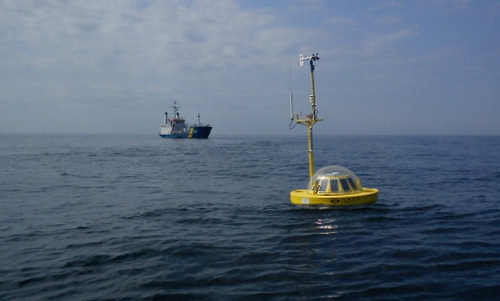2014's expensive Swedish submarine hunt seems to stem from a broken weather buoy offshore.
The incident of "territorial infringement" that initiated the 2014 Swedish submarine hunt campaign was not the aftermath of an unauthorized intrusion, but stemmed from an ocean data collection buoy ( ODAB) deployed by the Swedish Meteorological and Hydrological Institute (SMHI) in the Baltic Sea, an unnamed military source revealed in an investigative reportage published by Svenska Dagbladet, one of Sweden's largest daily newspapers. /ten.

The probe MS Fyrbyggaren approaches an ODAB buoy Photo: Eurogoos
Sweden began a large-scale operation to track submarines in the Kanholmsfjärden Bay in October 2014, after the discovery of an encrypted signal on the emergency radio frequency used by the Russian military. The Swedish military at the time thought the source was a submarine and a military base in Russia's Kaliningrad territory.
The search went on for days after Swedish officials confirmed a nation was conducting a submarine campaign off the coast. However, they did not detect any signs of Russian submarines, even without evidence that such vehicles have appeared in territorial waters.
"The search operation has yielded no results because no country has violated Swedish waters," the source said.
One of the ODAB buoys off Sweden went into trouble in mid-October 2014, forcing SMHI to deploy the MS Fyrbyggaren for repairs. The ship emits a coded hydrophonic signal to locate and communicate with the weather buoy. This signal was discovered by the older Södermanland class of the Swedish navy and is considered to be the clearest evidence of "territorial sea intrusion".
Subsequent analyzes by the Swedish Ministry of Defense also questioned the conclusion of "foreign invasion submarines". Data obtained on more modern Gotland class submarines also reject this hypothesis.
The Swedish government and military were reported on the mistake in May 2015, about seven months after the end of the submarine hunt. The country's parliament receives the notice about four months later. In a secret report to the government in September 2015, the Swedish military still asserted "firmly as a nail" on a violation of its territorial waters.
Around that time, the Swedish government approved a new defense expenditure. For the first time in more than 20 years, Stockholm has decided to maintain an increase in its defense budget from 4.3 billion USD in 2016 to more than 5 billion USD in 2020.
The Swedish military also added another billion dollars and many resources to improve its anti-submarine capabilities. In late June 2015, Stockholm ordered an advanced Blekinge-class submarine, and spent $ 860 million to upgrade two Gotland-class submarines.



 JamilHassan
JamilHassan







